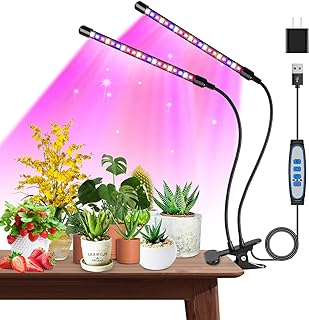5 important factors worth considering when looking for the best energy efficient grow lights
Choosing energy-efficient grow lights is crucial for indoor gardening enthusiasts who want to help their plants grow well and reduce their environmental impact. When picking the right grow lights, it’s important to look at more than just how bright they are and how much area they cover. Efficiency, spectrum, how long they last, and their sustainability are all important factors in creating a successful indoor garden. By carefully considering these important aspects, you can create a thriving indoor garden that is sustainable and good for your plants, all while aligning with your environmentally-friendly values.
See our guide to the best energy efficient grow lights.
Light spectrum
Selecting energy-efficient grow lights requires an understanding of the light spectrum. The type of light emitted by these lights directly affects how plants grow, flower, and produce. Plants have different light needs; blue light helps with growth, while red light is essential for flowering and fruiting. To promote healthy plant growth and get the most out of them, it’s best to use grow lights that have a good mix of both blue and red light. This way, plants get all the light they need for each stage of their growth, which is crucial for photosynthesis and overall health.
The quality and strength of light from energy-efficient grow lights are also key for strong plant growth and good crop quality. Choosing high-quality lights that mimic natural sunlight ensures plants get the right light for photosynthesis. By controlling the type and strength of light, growers can adjust how plants grow, when they flower, and how productive they are. By picking the right energy-efficient grow lights with a full range of light options and adjustable strength, indoor gardening projects can be more successful. This creates an environment similar to outdoor growing, leading to healthy plants and a good yield.
Energy efficiency
Investing in energy-efficient grow lights is important for our environment and future. When we choose energy-efficient grow lights, we are helping to reduce our carbon footprint and support sustainability in farming. They not only save money on electricity but also help preserve our planet’s resources.
It’s important to prioritize energy efficiency in all aspects of our lives, including agriculture. Energy-efficient grow lights not only help the environment but also improve plant growth and yield, making them a good choice for farmers and consumers. Let’s make conscious choices like using energy-efficient grow lights to create a more eco-friendly agricultural industry as we work towards a greener future.
Coverage area
When you buy energy-efficient grow lights, it’s important to think about how much area they can cover. Some people only focus on the brightness or type of light and forget about how much space they need to light up. If you don’t think about the coverage area, your plants might not get enough light which could result in them not growing well or producing enough. You should figure out the square footage of your growing space and pick lights that can cover the whole area to make sure your plants grow properly.
Not thinking about the coverage area can also affect how much energy your lights use and how much it costs to run them in the long term. If your lights don’t cover the whole area, you might need to buy more lights, which will use more electricity and make your bills go up. By choosing lights that match the size of your growing space, you can save energy, spend less money on operating costs, and give your plants the best environment to thrive. In summary, when you’re buying energy-efficient grow lights, considering the coverage area is key to having a successful and sustainable indoor garden.
Durability
When you’re thinking about buying energy-efficient grow lights, it’s important to focus on how long they will last. Choosing lights that are durable will save you money in the long run because they will work well for a long time. Durable lights can handle the everyday wear and tear of growing plants and will keep working consistently for a long time. To make sure your grow lights last, it’s important to pick ones made with good materials and solid construction.
Durability is key to saving money when you buy energy-efficient grow lights. While sturdier lights might cost more upfront, you’ll save money over time by not having to replace them as often. Durable lights also help reduce waste since you won’t need to throw them away and buy new ones frequently. By choosing durable energy-efficient grow lights, you not only protect your investment but also help the environment by promoting sustainable practices in your gardening.
Heat output
When you buy energy-efficient grow lights, it’s important to consider the heat they produce. Heat can affect how well your plants grow. Choosing lights with lower heat output can help your plants grow better and avoid getting burned. It’s important to find a balance between saving energy and controlling heat so your plants get the right amount of light without getting too hot.
Efficient grow lights that manage heat well can make your indoor garden more efficient and help your plants grow healthier. By selecting lights that spread heat out well, you can make a stable environment for your plants. Heat can impact how plants grow, so investing in energy-efficient grow lights with good heat control can help your indoor garden thrive. Keeping the right balance between energy savings and heat control is key to getting the most out of your grow lights and helping your plants grow their best.
Conclusion
In today’s world, it’s important to use energy-efficient grow lights to help the environment. These lights use new technology and eco-friendly methods to grow plants better and protect the planet for the future. When we use these lights in our gardens and inside our homes, we are taking a big step towards a more sustainable way of living with nature.


